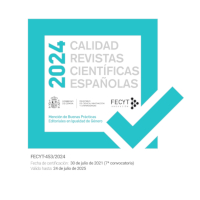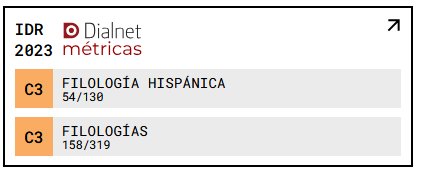Paper Tombs. Magical Realism in The Urban Tales of Eugenio Mimica
DOI:
https://doi.org/10.18172/cif.6336Keywords:
Magic realism, Emerging Literature, Chilean literature, Magellanic literature, Eugenio MimicaAbstract
This paper explores the narrative approach adopted by the short stories in the volume Enclave para dislocados by Chilean writer Eugenio Mimica, based on the concept of magical realism. The definition of the term is organized based on certain characteristics recognized by some literary critics, who also point out its distinction from fantasy literature and the marvelous real. In this case, Mimica's emerging work speaks to us of the unusual that can occur in the southern Magellanic lands of the country, provoking remarkable events for the characters, who do not seem surprised by the eventual intervention of the unusual in their lives.
Downloads
References
ARRATIA, M. (2011). Fundación narrativa de la Patagonia. Punta Arenas, Ediciones Universidad de Magallanes.
BARRIENTOS, Ó. (2001). “Corazas de hielo gruñen en el Fondo de los Fiordos. Revisión crítica de la Nueva Literatura Magallánica”. Pluvial. Revista de literatura y humanidades, 2: 136-142.
BAUTISTA, G. (1991). “El realismo mágico: historiografía y características”. Verba Hispanica, 1: 19-25. https://doi.org/10.4312/vh.1.1.19-25 DOI: https://doi.org/10.4312/vh.1.1.19-25
BIANCHI, S. (1997). “De qué hablamos cuando decimos nueva narrativa chilena”. En Carlos Olivárez (ed.), Nueva Narrativa Chilena. Santiago de Chile: LOM Ediciones, pp. 29-34.
BLUME, J. y CLEMENS, F. (2006). La crítica literaria del siglo XX. Santiago de Chile, Ediciones Universidad Católica de Chile.
CARRASCO, I. (2005). “Literatura chilena: canonización e identidades”. Estudios Filológicos, 40: 29-48. http://doi.org/10.4067/S0071-17132005000100002 DOI: https://doi.org/10.4067/S0071-17132005000100002
ESPINOZA, P. (1997). “Narrativa chilena hoy”. En Carlos Olivárez (ed.), Nueva Narrativa Chilena. Santiago de Chile, LOM Ediciones, pp. 65-74.
EVEN-ZOHAR, I. (2017). Polisistemas de cultura. Tel Aviv, Universidad de Tel Aviv, Laboratorio de Investigación de la Cultura.
FERNÁNDEZ, M. (2008). N…13: La generación emergente de escritores chilenos. Santiago de Chile, Universidad Metropolitana de Ciencias de la Educación.
FLORES, A. (1955). “Magical Realism in Spanish American Fiction”. Hispania, 2: 187-192. https://doi.org/10.2307/335812 DOI: https://doi.org/10.2307/335812
GODZICH, W. (1998). Teoría literaria y crítica de la cultura. Madrid, Cátedra.
GONZÁLEZ, M. (1999). Claves para entender la literatura emergente de fin de siglo. Santiago de Chile, Universidad Tecnológica Metropolitana.
GONZÁLEZ, J. (2017). “El realismo mágico: una categoría crítica necesitada de revisión”. Tropelías. Revista de Teoría de la Literatura y Literatura Comparada, 1: 116-121. https://doi.org/10.26754/ojs_tropelias/tropelias.201712105 DOI: https://doi.org/10.26754/ojs_tropelias/tropelias.201712105
IRVING, L. (1992). Books of the Brave. Being an Account of Books and of Men in the Spanish Conquest and Settlement of the Sixteenth-Century New World. Berkeley, University of California Press.
KOFMAN, A. (2017). “Las fuentes del realismo mágico en la literatura latinoamericana”. La Colmena, 85: 9-17. https://lacolmena.uaemex.mx/article/view/5318
LIVACIC, E. (1988). Historia de la Literatura de Magallanes. Punta Arenas, Ediciones Universidad de Magallanes.
LLARENA, A. (1994). “Claves para “El realismo mágico” y “Lo real maravilloso” espacio y actitud en cuatro novelas latinoamericanas”. Vector plus: miscelánea científico-cultural, 2: 15-27.
LLARENA, A. (1997). “Un balance crítico: la polémica del realismo mágico y lo real maravilloso americano (1955-1993)”. Anales de Literatura Hispanoamericana, 26(1), 107: 107-117. https://revistas.ucm.es/index.php/ALHI/article/view/ALHI9797120107A
LÓPEZ, L. (2011). “Discurso utópico/distópico regionalista en Un adiós al descontento de Eugenio Mimica”. Literatura y Lingüística, 23: 47-64. http://doi.org/10.4067/S0716-58112011000100004 DOI: https://doi.org/10.4067/S0716-58112011000100004
LÓPEZ, L. (2017). LOS PERGAMINOS DE LA MEMORIA. El genocidio indígena de la Patagonia austral (1880-1920) en la obra de los poetas magallánicos Juan Pablo Riveros, Pavel Oyarzún y Christian Formoso. Santiago de Chile, Editorial Cuarto Propio.
MENTON, S. (1994). “El realismo mágico en la pintura y en la literatura de tres continentes: 1918-1978”. En Biblioteca Luis-Ángel Arango (ed.), Cuarta cátedra internacional de arte Luis-Angel Arango. Realismo mágico, pintura y literatura 1918-1981. Bogotá, Banco de la República, pp. 7-15.
MENTON, S. (1998). Historia verdadera del realismo mágico. México D. F., Fondo de Cultura Económica.
MIMICA, E. (1995). Enclave para dislocados. Punta Arenas, Editorial Atelí.
MOORE, L. (1998). “Realismo mágico”. Estudios postcoloniales at Emory Pages. http://mrhoyesibwebsite.com/Prose%20Texts/Chronicle/Critical%20Articles/Magical%20Realism%20-%20Lindsay%20Moore.htm
NÓMEZ, N. (2007). “Transformaciones de la poesía chilena entre 1973 y 1988”. Estudios Filológicos, 42: 141-154. DOI: https://doi.org/10.4067/S0071-17132007000100009
OLIVÁREZ, C. (1997). “Prólogo”. En Carlos Olivárez (ed.); Nueva Narrativa Chilena. Santiago de Chile, LOM Ediciones, pp. 9-11.
OYARZÚN, P. y MAGAL, J. (1998). Antología InSURgente, la nueva poesía Magallánica. Punta Arenas, Ilustre Municipalidad de Punta Arenas.
PARKINSON, L. y FARIS, W. (1995). Magical Realism. Theory, History, Community. Durham, Duke University Press.
PROMIS, J. (1995) [1977]. Testimonios y documentos de la literatura chilena. Santiago de Chile, Editorial Andrés Bello.
ROAS, D. (2014). “El reverso de lo real: Formas y categorías de lo insólito”. En Javier Ordiz (ed.); Estrategias y figuraciones de lo insólito en la narrativa mexicana (siglos XIX–XXI). Bern, Peter Lang, pp. 9-29.
RODRÍGUEZ, J., GARCÍA, M., MORA, G. y HERRERA, J. (2020). “Literatura emergente del sur de Chile en el siglo XXI. Aproximaciones a sus repertorios e interrelaciones sistémicas”. Revista Chilena de Literatura, 102: 531-549. https://revistaliteratura.uchile.cl/index.php/RCL/article/view/60164 DOI: https://doi.org/10.4067/S0718-22952020000200531
SUBERCASEAUX, B. (1999). Chile o una loca historia. Santiago de Chile, LOM Ediciones.
VEGA, C. (1987). “Suplemento Literario”. La Prensa Austral 9: 9.
Downloads
Published
How to Cite
Issue
Section
License
Copyright (c) 2025 Lorena P. Lopez Torres

This work is licensed under a Creative Commons Attribution 4.0 International License.
The authors retain copyright of articles and authorize CIF the first publication. They are free to share and redistribute the article without obtaining permission from the publisher as long as they give appropriate credit to the editor and the journal.
Self-archiving is allowed too. In fact, it is recommendable to deposit a PDF version of the paper in academic and/or institutional repositories.
It is recommended to include the DOI number.
This journal is licensed under a Creative Commons Attribution 4.0 International License














